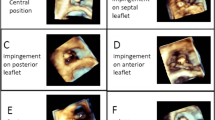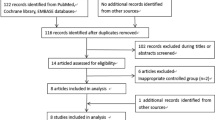Abstract
Purpose
To evaluate the association between different right ventricular (RV) lead positions as assessed by cardiac computed tomography (CT) and echocardiographic and clinical outcomes in patients receiving cardiac resynchronization therapy (CRT).
Methods
We reviewed patient records of all 278 patients included in two randomized controlled trials (ImagingCRT and ElectroCRT) for occurrence of heart failure (HF) hospitalization or all-cause death (primary endpoint) during long-term follow-up. Outcomes were compared between RV lead positions using adjusted Cox regression analysis. Six months after CRT implantation, we estimated left ventricular (LV) reverse remodeling by measuring LV end-systolic and end-diastolic volumes by echocardiography. Changes from baseline to 6 months follow-up were compared between RV lead positions. Device-related complications were recorded at 6-month follow-up.
Results
During median (interquartile range) follow-up of 4.7 (2.9–7.1) years, the risk of meeting the primary endpoint was similar for patients with non-apical vs. apical RV lead position (adjusted hazard ratio (HR) 0.78, 95% confidence interval (CI) 0.54–1.12, p = 0.17) and free wall vs. septal RV lead position (adjusted HR 1.03, 95% CI 0.72–1.47, p = 0.86).
Changes in LV ejection fraction and dimensions were similar with the different RV lead positions. We observed no differences in device-related complications relative to the RV lead position.
Conclusions
In patients receiving CRT, the risk of HF hospitalization or all-cause death during long-term follow-up, and LV remodeling and incidence of device-related complications after 6 months are not associated with different anatomical RV lead position as assessed by cardiac CT.





Similar content being viewed by others
References
Glikson M, Nielsen JC, Kronborg MB, Michowitz Y, Auricchio A, Barbash IM, et al. 2021 ESC Guidelines on cardiac pacing and cardiac resynchronization therapy: Developed by the Task Force on cardiac pacing and cardiac resynchronization therapy of the European Society of Cardiology (ESC) With the special contribution of the European Heart Rhythm Association (EHRA). Eur heart J. 2021.
Abraham WT, Fisher WG, Smith AL, Delurgio DB, Leon AR, Loh E, et al. Cardiac resynchronization in chronic heart failure. N Engl J Med. 2002;346:1845–53.
Bristow MR, Saxon LA, Boehmer J, Krueger S, Kass DA, De Marco T, et al. Cardiac-resynchronization therapy with or without an implantable defibrillator in advanced chronic heart failure. N Engl J Med. 2004;350:2140–50.
Cleland JG, Daubert JC, Erdmann E, Freemantle N, Gras D, Kappenberger L, et al. The effect of cardiac resynchronization on morbidity and mortality in heart failure. N Engl J Med. 2005;352:1539–49.
Kronborg MB, Mortensen PT, Kirkfeldt RE, Nielsen JC. Very long term follow-up of cardiac resynchronization therapy: clinical outcome and predictors of mortality. Eur J Heart Fail. 2008;10:796–801.
Yu CM, Sanderson JE, Gorcsan J 3rd. Echocardiography, dyssynchrony, and the response to cardiac resynchronization therapy. Eur Heart J. 2010;31:2326–37.
Mullens W, Grimm RA, Verga T, Dresing T, Starling RC, Wilkoff BL, et al. Insights from a cardiac resynchronization optimization clinic as part of a heart failure disease management program. J Am Coll Cardiol. 2009;53:765–73.
Miranda RI, Nault M, Johri A, Simpson CS, Michael KA, Abdollah H, et al. Maximal electric separation-guided placement of right ventricular lead improves responders in cardiac resynchronization defibrillator therapy. Circ Arrhythm Electrophysiol. 2012;5:927–32.
Kutyifa V, Bloch Thomsen PE, Huang DT, Rosero S, Tompkins C, Jons C, et al. Impact of the right ventricular lead position on clinical outcome and on the incidence of ventricular tachyarrhythmias in patients with CRT-D. Heart Rhythm. 2013;10:1770–7.
Asbach S, Lennerz C, Semmler V, Grebmer C, Solzbach U, Kloppe A, et al. Impact of the right ventricular lead position on clinical end points in CRT recipients–a subanalysis of the multicenter randomized SPICE trial. Pacing Clin Electrophysiol. 2016;39:261–7.
Thébault C, Donal E, Meunier C, Gervais R, Gerritse B, Gold MR, et al. Sites of left and right ventricular lead implantation and response to cardiac resynchronization therapy observations from the REVERSE trial. Eur Heart J. 2012;33:2662–71.
Leclercq C, Sadoul N, Mont L, Defaye P, Osca J, Mouton E, et al. Comparison of right ventricular septal pacing and right ventricular apical pacing in patients receiving cardiac resynchronization therapy defibrillators: the SEPTAL CRT Study. Eur Heart J. 2016;37:473–83.
Khan FZ, Salahshouri P, Duehmke R, Read PA, Pugh PJ, Elsik M, et al. The impact of the right ventricular lead position on response to cardiac resynchronization therapy. Pacing Clin Electrophysiol. 2011;34:467–74.
Daimee UA, Klein HU, Giudici MC, Zareba W, McNitt S, Polonsky B, et al. Right ventricular lead location, right-left ventricular lead interaction, and long-term outcomes in cardiac resynchronization therapy patients. J Interv Card Electrophysiol. 2018;52:185–94.
Kronborg MB, Johansen JB, Haarbo J, Riahi S, Philbert BT, Jørgensen OD, et al. Association between implantable cardioverter-defibrillator therapy and different lead positions in patients with cardiac resynchronization therapy. Europace. 2018;20:e133–9.
Kronborg MB, Johansen JB, Riahi S, Petersen HH, Haarbo J, Jørgensen OD, et al. Association between right ventricular lead position and clinical outcomes in patients with cardiac resynchronization therapy. Europace. 2018;20:629–35.
Sommer A, Kronborg MB, Nørgaard BL, Gerdes C, Mortensen PT, Nielsen JC. Left and right ventricular lead positions are imprecisely determined by fluoroscopy in cardiac resynchronization therapy: a comparison with cardiac computed tomography. Europace. 2014;16:1334–41.
Rickard J, Ingelmo C, Sraow D, Wilkoff BL, Grimm RA, Schoenhagen P, et al. Chest radiography is a poor predictor of left ventricular lead position in patients undergoing cardiac resynchronization therapy: comparison with multidetector computed tomography. J Interv Card Electrophysiol. 2011;32:59–65.
Sommer A, Kronborg MB, Norgaard BL, Poulsen SH, Bouchelouche K, Bottcher M, et al. Multimodality imaging-guided left ventricular lead placement in cardiac resynchronization therapy: a randomized controlled trial. Eur J Heart Fail. 2016;18:1365–74.
Stephansen C, Sommer A, Kronborg MB, Jensen JM, Nørgaard BL, Gerdes C, et al. Electrically vs. imaging-guided left ventricular lead placement in cardiac resynchronization therapy: a randomized controlled trial. Europace. 2019;21:1369–77.
Benz AP, Vamos M, Erath JW, Bogyi P, Duray GZ, Hohnloser SH. ICD lead type and RV lead position in CRT-D recipients. Clin Res Cardiol. 2018;107:1122–30.
Zografos TA, Siontis KC, Jastrzebski M, Kutyifa V, Klein HU, Zareba W, et al. Apical vs. non-apical right ventricular pacing in cardiac resynchronization therapy: a meta-analysis. Europace. 2015;17:1259–66.
Moore P, Coucher J, Ngai S, Stanton T, Wahi S, Gould P, et al. Imaging and right ventricular pacing lead position: a comparison of CT, MRI, and echocardiography. Pacing Clin Electrophysiol. 2016;39:382–92.
Rickard J, Michtalik H, Sharma R, Berger Z, Iyoha E, Green AR, et al. Predictors of response to cardiac resynchronization therapy: a systematic review. Int J Cardiol. 2016;225:345–52.
Merchant FM, Heist EK, Nandigam KV, Mulligan LJ, Blendea D, Riedl L, et al. Interlead distance and left ventricular lead electrical delay predict reverse remodeling during cardiac resynchronization therapy. Pacing Clin Electrophysiol. 2010;33:575–82.
Fyenbo DB, Sommer A, Nørgaard BL, Kronborg MB, Kristensen J, Gerdes C, et al. Long-term outcomes in a randomized controlled trial of multimodality imaging-guided left ventricular lead placement in cardiac resynchronization therapy. Europace. 2022. https://doi.org/10.1093/europace/euab314.
Funding
This work was supported by Aarhus University, the Danish Heart Foundation (grant number R140-A9482-B2407), Health Research Foundation of Central Denmark Region (grant number R64-A3194-B1667), and Gangstedfonden.
Author information
Authors and Affiliations
Corresponding author
Ethics declarations
Conflict of interest
JCN is supported by grants from the Novo Nordisk Foundation (grant number NNF16OC0018658, NNF17OC0029148). HKJ is supported by grants from the Novo Nordisk Foundation, Denmark (NNF18OC0031258 and NNF20OC0065151), and received lecture fees from Abbott Denmark and Biosense Webster, Europe. All other declare no conflicts of interest.
Additional information
Publisher's note
Springer Nature remains neutral with regard to jurisdictional claims in published maps and institutional affiliations.
Supplementary Information
Below is the link to the electronic supplementary material.
Rights and permissions
About this article
Cite this article
Fyenbo, D.B., Sommer, A., Stephansen, C. et al. Cardiac computed tomography-verified right ventricular lead position and outcomes in cardiac resynchronization therapy. J Interv Card Electrophysiol 64, 783–792 (2022). https://doi.org/10.1007/s10840-022-01193-1
Received:
Accepted:
Published:
Issue Date:
DOI: https://doi.org/10.1007/s10840-022-01193-1




